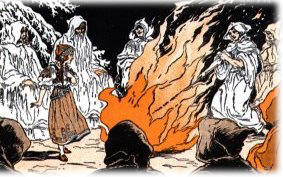The History of Halloween
by aintveld | October 17, 2012 6:05 pm
By ASHLEY INTVELD
It’s the night notorious for mischief, disguises, and the door-to-door hunt for delectable treats by dozens of trick-or-treaters eager to fill their sacks. According to an estimate provided by National Retail Federation[1], Halloween sales are expected to rake in about $8 billion this year[2], making the holiday the second largest commercial holiday in America.
Jack ‘O Lanterns[3] aglow and streets strewn with goblins, ghosts and ghouls of all shapes and sizes, America has defined Oct. 31 as the night of sweet treats and creative costumes. From Paganism[4] to party-night, Halloween has undergone a transformation over the last 2,000 years.
“We view Halloween as a trivial holiday, a day for children to let their imaginations run wild and take in the guise of a variety of icons,” said history buff Tim O’Connor of Dingmans Ferry, PA. “The root of these celebrations, however, are based on a day of observance over a millennium old, if not older.”
 [5]
[5]Centuries before it became what it is today, Halloween served as a night of prophesy rather than partying. Samhain[6], the festival for the Celtic new year, marked the day when summer ended and winter began. Associating winter with human death, the Celts believed that the border between the living and the dead became blurred, and the dead would return in the form of ghosts. It was thought that in the presence of these spirits, the Druids, or priests, were better suited to form prophesies.
People would build a bonfire as a sacrifice to the Celtic gods while wearing costumes comprised of animal heads and skins and attempt to predict each other’s futures. They would later light their own hearth fires with the bonfire’s flames for protection from winter’s devastation.
“There are arguments that All Saints Day and All Souls Day observed in Christianity were formed completely independently from Samhain, however there are too many themes linking the festivals,” O’Connor said.
After the Roman Empire had begun to rule most of the Celtic territory, two Roman festivals began to integrate with the Celtic Samhain. The first was a day of commemoration of the dead, and the other was in celebration of the Roman goddess of fruit and trees, Pomona[7]. Pomona’s symbol, the apple, is widely accepted as the meaning behind the Halloween tradition of bobbing for apples.
As Christianity spread to Celtic land, Christian holidays like All Saints’ Day (Nov 1) and All Souls Day (Nov 2) began to supplant the Celtic festival with similar rituals, but church-oriented. Similar to Samhain, All Souls’ Day was celebrated with bonfires, costumes, and parades. All Saints Day was otherwise called All-hollowmas, and the night before was called All-hallows Eve, leading to today’s accepted title “Halloween.”
America’s Twist on Halloween
The integration of Halloween customs in America was slow-moving at first considering the Protestant belief systems devoutly in place. As European influence blended with Native American traditions, the first harvest festivals in America took place which featured a celebration of the bounty as well as the sharing of ghost-stories.
 [8]
[8]With the influx of Irish immigrants fleeing the potato famine [9]in 1846, Halloween gained popularity in the States. Taking from the All Souls’ Day tradition of “going-a-souling,” or praying for a deceased family member in exchange for food, “trick-or-treating” became a way for American communities to come together and enjoy the holiday’s festivities. “The commonality of Samhain and the two Christian holy days is a stark contrast to how Halloween is observed in American culture today,” O’Connor said. “Elements of both pagan and Christian observances still exist, but Halloween as a spiritual and harvest holiday has limited influence.”
Historically, people put bowls of food outside their homes for roaming ghosts as a means of protection. Now, bowls of candy are left out to simplify the task of trick-or-treating. Costumes, now used for a night of false identity, were once a way to trick returning spirits into believing the people were fellow spirits and so they would remain unharmed.
“Superheroes, monsters, or even something so ordinarily grand as a doctor can be seen on our streets in the form of droves of children chasing dreams of a sack full of candy. Adults also revel in the chance to be someone else on Halloween and let their inhibitions go,” O’Connor said.
Today, Halloween offers people of all ages a night of projected imagination and creativity. Donella Askew, former actor for Heaven Hil[10]l’s Haunted Hayride in Vernon said, “I feel we still celebrate Halloween because it gives children and adults a reason to dress up and get candy.” According to History.com, one quarter of all annual candy sales are attributed to the Halloween holiday; a sweet turnout for its bitter history.
http://storify.com/ashleyintveld11/pagan-to-party-the-history-of-halloween[11]
What are your plans for Halloween this year?[12]
- National Retail Federation: http://www.nrf.com/modules.php?name=Pages&sp_id=1&pmenu_id=1
- $8 billion this year: http://www.nrf.com/modules.php?name=News&op=viewlive&sp_id=1430
- Jack ‘O Lanterns: http://www.history.com/topics/jack-olantern-history
- Paganism: http://www.bbc.co.uk/religion/religions/paganism/
- [Image]: http://class1.ramaporecord.org/2012/10/17/the-history-of-halloween/samhai1/
- Samhain: http://www.history.com/topics/halloween
- Pomona: http://paganwiccan.about.com/od/mabontheautumnequinox/p/Pomona.htm
- [Image]: http://class1.ramaporecord.org/2012/10/17/the-history-of-halloween/photo-6/
- potato famine : http://www.digitalhistory.uh.edu/historyonline/irish_potato_famine.cfm
- Heaven Hil: http://www.heavenhillfarm.com/
- http://storify.com/ashleyintveld11/pagan-to-party-the-history-of-halloween: http://storify.com/ashleyintveld11/pagan-to-party-the-history-of-halloween
- What are your plans for Halloween this year?: http://class1.ramaporecord.org/2012/10/17/the-history-of-halloween/121011_004/
Source URL: https://class1.ramaporecord.org/?p=9564